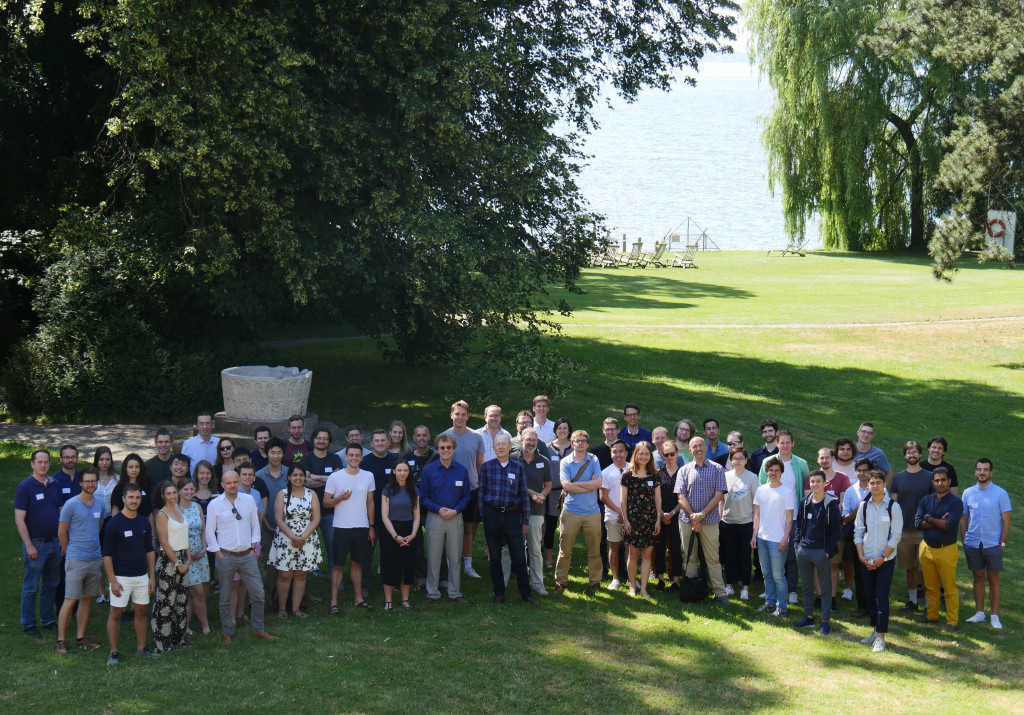BCCN/UCL Navigation retreat 2019 | 03 - 05 July 2019, Tutzing

Foto: EA Tutzing
Wednesday, July 3
12:30 Lunch
13:30 Hang up posters
14:00 Poster session I and coffee/tea
15:00 Welcome/Introduction to the retreat by Virginia Flanagin
Session 1: Environmental influences - Chair: Virginia Flanagin
- 15:30 Julija Krupic - Medial entorhinal grid deformations in large irregular spaces
- 16:00 Roddy Grieves (Jeffrey lab) - Environment structure shapes the place cell representation of volumetric space in rats
- 16:30 Sander Tanni (Barry lab) - Place cell code in different scale environments
- 17:00 Michael Schutte (Wiegrebe lab) - Human echo-acoustic navigation
18:00 Dinner
19:00 Poster session II and drinks
Thursday, July 4
08:00 Breakfast
Session 2: Spatial and neural behaviour I - Chair: Kay Thurley
- 09:00 Anton Sirota - Behavioral state modulation of spatial coding in hippocampus
- 09:30 Markus Frey (Barry lab) - A general framework for decoding behaviour from wide-band neural activity
- 10:00 Johannes Nagele (Herz lab) - Trial-to-trial variability of grid-cell spiking
- 10:30 Coffee/tea and posters
Session 3: Spatial and neural behaviour II - Chair: Caswell Barry
- 11:00 Johannes Zirkelbach (Herz lab) - Anticipation in head-direction cells
- 11:30 Stefan Glasauer - Bayesian models for homing
- 12:00 Kate Jeffery - Integrating spatial reference frames
12:30 Lunch
Session 4: Plasticity and memory I - Chair: Andreas Herz
- 14:00 Ricardo Santos (Sirota lab) - Probing cholinergic modulation of hippocampal rhythms underlying memory encoding and consolidation
- 14:30 Daniel Bush (Burgess lab) - Human hippocampal theta in spatial and episodic memory function
- 15:00 Alessio Attardo - Stability of excitatory connectivity in dorsal CA1 predicts plasticity patterns and memory recall in mice
15:30 Poster session III and coffee/tea
Session 5: Plasticity and memory II - Chair: Neil Burgess
- 17:00 Jesse Geerts (Burgess lab) - A model of hippocampal and striatal contributions to learning
- 17:30 Tom Wills - The post-natal development of neural mechanisms for memory consolidation
- 18:00 Yi Lu (Cacucci/Wills lab) - Absence of visual input affects place cell and grid cell activity
18:30 Dinner
Friday, July 5
08:00 Breakfast
Session 6: Sequences and replay - Chair: Kate Jeffery
- 09:00 Eléonore Duvelle (Jeffery lab) - Hippocampal replay during complex space navigation
- 09:30 Christian Leibold - Computing with hippocampal sequences
- 10:00 Coffee/tea
- 10:30 Talfan Evans (Burgess lab) - A mode of coordinated HPC-mEC replay as spatial inference
- 11:00 Andreas Herz - Spike afterpotentials shape bursting in MEC
11:30 Wrap up by Kate Jeffery
12:00 Lunch
Posters
Castello-Waldow, Tim P, G Weston, Y Loewenstein, Alireza Chenani, A
Chen, and Alessio Attardo.
Understanding the relationship between
long-term synaptic dynamics and neuronal activity in hippocampal CA1
Chaudhuri-Vayalambrone, Prannoy, Marino Krstulovic, Marius Bauza, and
Julija Krupic.
Local changes, global effects? How localised is the
effect of deformed boundaries on grid cell firing patterns?
Chen, Weiwei and Anton Sirota.
Frequency domain spatiotemporal
pattern separation of local field potential
Cheng, Han Yin, Dorothy Overington, and Kate Jeffery.
Navigation in
a visually ambiguous environment: local or place encoding?
Csordás, Dóra É, Caroline Fischer, Johannes Nagele, Martin Stemmler, and
Andreas VM Herz.
Spike afterpotentials shape the burst activity of
cells in the entorhinal cortex during navigation
de Cothi, Will and Caswell Barry.
Neurobiological successor
features for spatial navigation
Donno, Carlo De, Anton Sirota, and Jakob Macke.
Anatomical origin
of space-coding features in the hippocampal LFP signal
Eberhardt, Florian, Andreas Herz, and Stefan Häusler.
Tuft
dendrites of pyramidal neurons operate as feedback-modulated functional
subunits
Fetterhoff, Dustin and Christian Leibold.
Spatial and image
selectivity of hippocampal neurons in virtual reality mazes
Garzorz, Isabelle, Alexander Knorr, Stefan Glasauer, and Ophelia
Deroy.
Interoceptive insight into self-motion perception
Glasauer, Stefan, Alexander Knorr, Isabelle Garzorz, and Margarete
Jahrmann.
Trajectory perception – a collective experiment
Kymn, Christopher, Stefan Häusler, Martin Stemmler, and Andreas Herz.
Do
autoencoders of place cell activity exhibit grid-like patterns?
O’Driscoll, Tara, Isabella Varsavsky, Laurenz Muessig, Francesca
Cacucci, and Tom Wills.
The post-natal development of temporal
coding in the rat hippocampus
Pröll, Michaela, Stefan Häusler, and Andreas Herz.
Field-to-field
variability of grid cells: A sign of altered burst activity?
Resnik, Evgeny, Gerrit Schwesig, Noriaki Ide, Justin Graboski, and Anton
Sirota.
Anatomical dissection of distinct high-frequency
oscillations in the hippocampus
Roppelt, Christopher, Josh Yudice, and Virginia L Flanagin.
Human
spatial navigation in sparse environments
Schutte, Michael, Michael Forsthofer, Boris Chagnaud, and Lutz
Wiegrebe.
Auditory perception of distance to rattlesnakes in an
audio-visual virtual environment
Sobolev, Andrey, Nick Del Grosso, Kay Thurley, Christian Leibold, and
Anton Sirota.
Influence of sensory conditions on the hippocampal
population code for space
Street, James and Kate Jeffery.
Impaired landmark anchoring of
postsubicular head direction cells in rats following lesions of the
lateral geniculate nucleus
Thurley, Kay, Anja Ries, Christopher Roppelt, and Virginia L
Flanagin.
General mechanisms for magnitude estimation in humans
Ulrich, Susanne, Eva Grill, and Virginia L Flanagin.
Cross-sectional
survey of wayfinding behavior
Weiß, Lennart, Maximilian Zillekens, and Bernhard Wolfrum.
Bridging
the gap: From abstract oddball experiments towards the classification
of sparse events using a hybrid EEG-fNIRS approach
Zhang, Ningyu and Kate Jeffery.
Stay oriented: visual landmarks as
dominant directional cues in the rat brain
